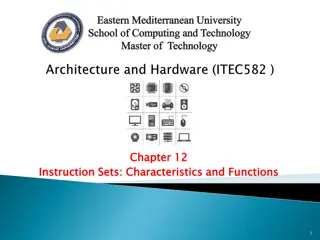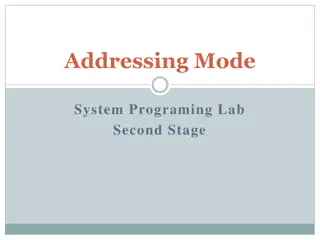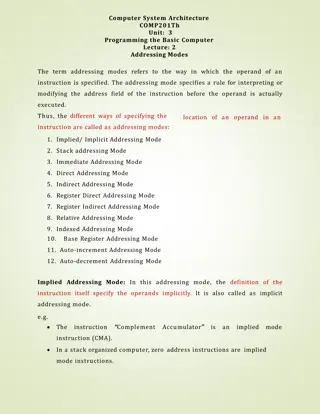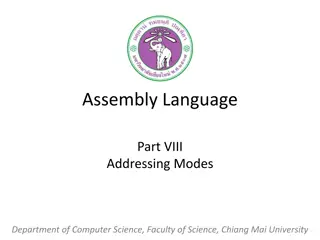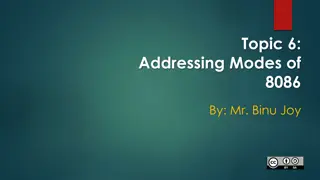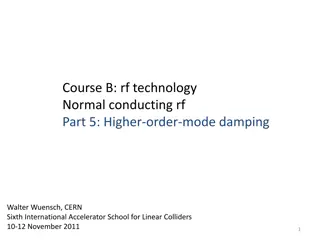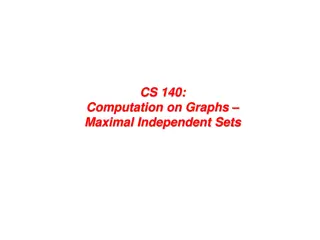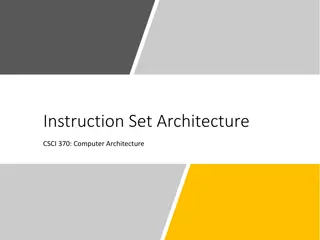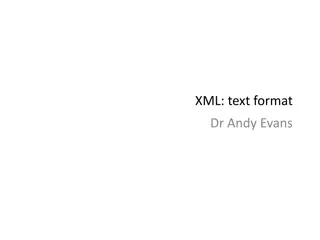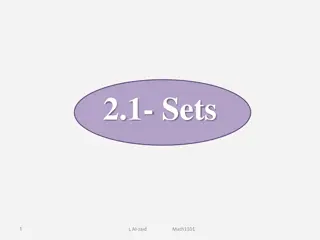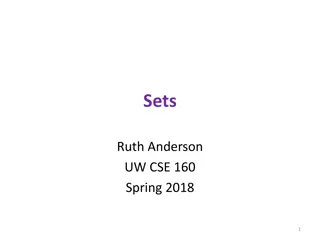Addressing Modes and Formats in Instruction Sets
This material discusses addressing modes and formats in instruction sets, covering types of addressing modes, design trade-offs, and the distinction between machine language and assembly language. It explores the need for various addressing techniques to reference locations in memory and presents common addressing techniques used in computer architectures.
Download Presentation

Please find below an Image/Link to download the presentation.
The content on the website is provided AS IS for your information and personal use only. It may not be sold, licensed, or shared on other websites without obtaining consent from the author. Download presentation by click this link. If you encounter any issues during the download, it is possible that the publisher has removed the file from their server.
E N D
Presentation Transcript
Eastern Mediterranean University School of Computing and Technology Master of Technology Chapter Addressing Modes and Formats Chapter 1 13 3 Instruction Sets Instruction Sets: : Addressing Modes and Formats
Learning Objectives After studying this chapter, you should be able to: Describe the various types of addressing modes common in instruction set Summarize the issues and trade-offs involved in designing an instruction format. Understand the distinction between machine language and assembly language 2
In the first chapter, we focused on what an instruction set does. Specifically, we examined the types of operands and operations that may be specified by machine instructions. This chapter turns to the question of how to specify the operands and operations of instructions. Two issues arise. First, how is the address of an operand specified ? Second, how are the bits of an instruction organized to define the operand addresses and operation of that instruction? 3
Why do we need the addressing modes? The address field or fields in a typical instruction format are relatively small. We would like to be able to reference a large range of locations in main memory or, for some systems, virtual memory. To achieve this objective, a variety of addressing techniques has been employed. 4
The most common addressing Immediate Direct Indirect Register Register indirect Displacement Stack addressing techniques techniques are: 5
Notations A A=contents of an address field in the instruction R R=contents of an address field in the instruction that refers to a register EA address of the location containing the referenced operand (X location X or register X Notations EA=actual (effective) (X) ) =contents of memory 6
Virtually all computer architectures provide more than one of these addressing modes. One or more bits in the instruction format can be used as a mode mode field field. The value of the mode field determines which addressing mode is to be processor. which addressing mode is to be used used by the 8
The second comment concerns the interpretation of the effective address (EA). In a system without virtual memory, the effective address will be either a main memory address or a register. In a virtual memory system, the effective address is a virtual address or a register. 9
Simplest form of addressing, the operand value is present in the instruction Operand= A where instruction where A A = contents of an address field in the This mode can be used to define and use constants or set initial values of variables Typically the number will be stored in twos complement form The leftmost bit of the operand field is used as a sign bit 10
Operand is part of instruction Operand = address field e.g. ADD 5 Add 5 to contents of accumulator 5 is operand MOV AL, 35 H ( move the data 35H into AL register) Instruction Opcode Operand 11
Advantage No memory reference other than the instruction fetch is required to obtain the operand, thus saving one memory or cache cycle in the instruction cycle. Disadvantage The size of the number is restricted to the size of the address field, which, in most instruction sets, is small compared with the word length. Advantage Disadvantage 12
Simple form of addressing EA=A Address field in the instruction contains the operand and no intermediate memory access is required It requires only one memory reference and no special calculation. The length of the address field is usually less than the word length, thus limiting the address range. This technique was common in earlier generations of computers. contains the EA of 13
e.g. ADD A Add contents of cell A to accumulator Look in memory at address A for operand Instruction Opcode Address A Memory Operand ADD R1, 4000 - In this the 4000 is EA of operand. 14
Indirect addressing is a scheme in which the address specifies which memory word or register contains not the operand but the address of the operand. EA = (A) Instruction execution requires two memory references to fetch the operand One to get its address e.g. ADD (A) Add contents of cell pointed to by contents of A accumulator address and a second to get its value get its value pointed to by contents of A to 15
Instruction Opcode Address A Memory Pointer to operand In address field in the instruction contains the memory location or register where EA of operand is present. It requires two memory access Indirect addressing mode, Operand 16
The obvious advantage of this approach is that for a word length of N, 2 ^ N address space are available. The disadvantage is that instruction execution requires two memory references to fetch the operand: one to get its address and a second to get its value. Large address space 2N where N = word length Multiple memory accesses to find operand Hence slower 17
Similar to direct addressing. The only difference is that the address field refers to a register rather than a main memory address. EA=R Operand contents of register R The advantages of register addressing are that (1) only a small address field is needed in the instruction, and (2) no time- consuming memory references are required. Operand is in memory cell pointed to by 19
Instruction Opcode Register Address R Registers Operand In this mode the operand is stored in the register and this register is present in CPU. The instruction has the address of the Register where the operand is stored. 20
In register indirect addressing mode; the address of operand is placed in any one of the registers. The instruction specifies a register that contains the address of the operand. Similar to indirect addressing EA = (R) Operand is in memory cell pointed to by contents of register R The advantages and limitations of register indirect addressing are basically the same as for indirect addressing Register indirect addressing uses one less memory reference than indirect addressing. 21
In this mode, the instruction specifies the register whose contents give us the address of operand which is in memory. Thus, the register contains the address of operand rather than the operand itself. Instruction Opcode Register Address R Memory Registers Operand Pointer to Operand 22
Combines the capabilities of direct addressing and register indirect addressing EA = A + (R) Address field hold two values A = base value The value contained in one address field (value = A) is used directly. R = register that holds displacement The other address field, or an implicit reference based on opcode, refers to a register whose contents are added to A to produce the effective address 24
Instruction Address A Opcode Register R Memory Registers Pointer to Operand Operand + 25
Most common uses of displacement addressing: Relative addressing Base-register addressing Indexing 26
The implicitly referenced register (R) is the program counter (PC) The next instruction address is added to the address field to produce the EA Typically the address field is treated as a twos complement number for this operation Thus the effective address is a displacement relative to the address of the instruction 27
The referenced register (R) contains a main memory address and the address field (A) contains a displacement from that address The register reference may be explicit or implicit In some implementations a single segment base register is employed and is used implicitly In others the programmer may choose a register to hold the base address of a segment and the instruction must reference it explicitly 28
The address field (A) references a main memory address and the referenced register (R) contains a positive displacement from that address. An important use is to provide an efficient mechanism for performing iterative operations. 29
Autoindexing Automatically increment or decrement the index register after each reference to it EA = A + (R) (R) (R) + 1 In some machines, both indirect addressing and indexing are provided, and it is possible to employ both in the same instruction. There are two possibilities: the indexing is performed either before or after the indirection. 30
If indexing is performed after the indirection, it is termed postindexing EA = (A) + (R) First, the contents of the address field are used to access a memory location containing a direct address. This address is then indexed by the register value. This technique is useful for accessing one of a number of blocks of data of a fixed format. F Preindexing Indexing is performed before the indirection EA = (A + (R)) An address is calculated as with simple indexing. In this case, however, the calculated address contains not the operand, but the address of the operand. 31
Remember that a stack locations works as a last-in-first-out queue. Items are appended to the top of the stack so that the block is partially filled at any time. Associated with the stack is a pointer whose value is the address of the top of the stack The stack pointer is maintained in a register Thus references to stack locations in memory are in fact register indirect addresses The machine instructions need not include a memory reference but implicitly operate on the top of the stack. stack is a linear array of 32
2. 2. Instruction Formats Instruction Formats An instruction format defines the layout of the bits of an instruction, in terms of its constituent fields. An instruction format must include an opcode and, implicitly or explicitly, zero or more operands. Each explicit operand is referenced using one of the addressing modes. The format must, implicitly or explicitly, indicate the addressing mode for each operand. For most instruction sets, more than one instruction format is used. 34
The most basic design issue is the instruction length. The decision affects, and is affected by: Memory size Memory organization Bus structure Processor complexity Processor speed The most obvious trade-off here is between the desire for a powerful instruction repertoire and a need to save space. affected by: 35
More opcodes and more operands make life easier for the programmer. Why? Because shorter programs can be written to accomplish given tasks. Similarly, more addressing modes give the programmer greater flexibility in implementing certain functions, such as table manipulations and multiple- way branching. And, of course, with the increase in main memory size and the increasing use of virtual memory, programmers want to be able to address larger memory ranges. All of these things (opcodes, operands, addressing modes, address range) require bits and push in the direction of longer instruction lengths. But longer instruction length may be wasteful. A 64-bit instruction occupies twice the space of a 32-bit instruction but is probably less than twice as useful. 36
Beyond this basic trade-off, there are other considerations. Either the instruction length should be equal to the memory-transfer length (in a bus system, data bus length) or one should be a multiple of the other. A related consideration is the memory transfer rate. This rate has not kept up with increases in processor speed. Accordingly, memory can become a bottleneck if the processor can execute instructions faster than it can fetch them. One solution to this problem is to use (i) cache memory; (ii) shorter instructions. Thus, 16-bit instructions can be fetched at twice the rate of 32-bit instructions but probably can be executed less than twice as rapidly. 37
Allocation of Bits Allocation of Bits An equally difficult issue is how to allocate the bits in that format. For a given instruction length, there is clearly a trade-off between the number of opcodes and the power of the addressing capability. More opcodes obviously mean more bits in the opcode field. For an instruction format of a given length, this reduces the number of bits available for addressing.!!!!!! There is one interesting refinement to this trade-off, and that is the use of variable-length opcodes. 38
In this approach, there is a minimum opcode length but, for some opcodes, additional operations may be specified by using additional bits in the instruction. For a fixed length instruction, this leaves fewer bits for addressing. Thus, this feature is used for those instructions that require fewer operands and/or less powerful addressing. The following interrelated factors go into determining the use of the addressing bits Number of addressing modes Number of operands Register versus memory Number of register sets Address range 39
The PDP-10 has a 36-bit word length and a 36-bit instruction length. The opcode occupies 9 bits, allowing up to 512 operations. In fact, a total of 365 different instructions are defined. Most instructions have two addresses, one of which is one of 16 general-purpose registers. Thus, this operand reference occupies 4 bits. 40
The other operand reference starts with an 18-bit memory address field. This can be used as an immediate operand or a memory address. The same general-purpose registers are also used as index registers. 41
Variations can be provided efficiently and compactly Increases the complexity of the processor Does not remove the desirability of making all of the instruction lengths integrally related to word length Because the processor does not know the length of the next instruction to be fetched a typical strategy is to fetch a number of bytes or words equal to at least the longest possible instruction Sometimes multiple instructions are fetched 42
Instructions are made up of: from zero to four optional instruction prefixes a 1-, 2- or 3-byte opcode an optional address specifier (which consists of the ModR/m byte and the Scale Index byte) an optional displacement an optional immediate field 45
The instruction prefix the LOCK prefix or one of the repeat prefixes. The LOCK shared memory in multiprocessor environments. The repeat string, which enables the x86 to process strings much faster than with a regular software loop. instruction prefix, if present, consists of LOCK prefix is used to ensure exclusive use of repeat prefixes specify repeated operation of a 46
Segment segment register an instruction should use, overriding the default segment-register selection generated by the x86 for that instruction. Segment override override explicitly specifies which An instruction has a default operand size 16 or 32 bits, and the operand prefix switches between 32-bit and 16-bit operands. operand size of 47
The processor can address memory using either 16- or 32-bit address size address size. The opcode opcode field is 1, 2, or 3 bytes in length. The ModR operand is in a register or in memory; if it is in memory, then fields within the byte specify the addressing mode to be used. ModR/m /m byte specifies whether an 48
Certain encoding of the ModR/m byte specifies the inclusion of the SIB specify fully the addressing mode. SIB byte to When the addressing-mode specifier indicates that a displacement is used, an 8-, 16-, or 32-bit signed integer displacement field is added. displacement Immediate 16-, or 32-bit operand. Immediate field provides the value of an 8-, 49
A processor can understand and execute machine instructions. Such instructions are simply binary numbers stored in the computer. If a programmer wishes to program directly in machine language, then it would be necessary to enter the program as binary data. Consider the simple BASIC statement N=I +J +K and suppose we wish to program this statement in machine language and to initialize I, J, and K to 2, 3, and 4, respectively. N=I +J +K 50

 undefined
undefined







